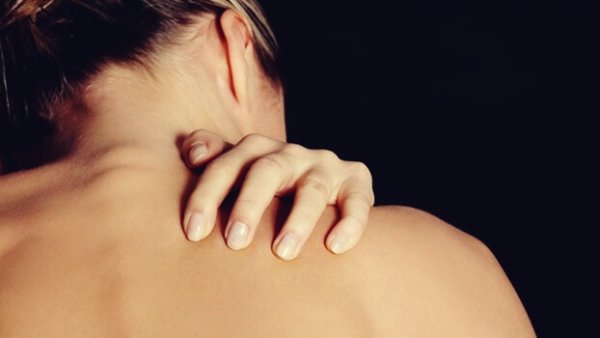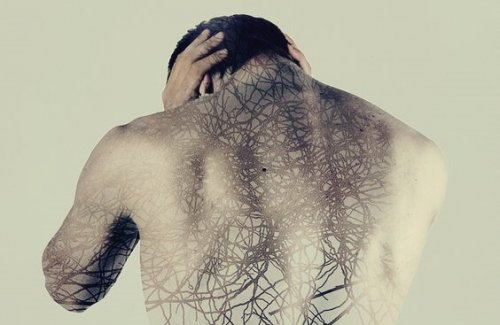The Relationship Between Your Skin and Your Emotions


Written and verified by the psychologist Gema Sánchez Cuevas
When you are sad or stressed, your skin appears rougher and less lustrous. It looks dehydrated and paler than normal. On the other hand, when you feel good, your skin seems to be in perfect harmony. This observation shows the revealing relationship between your skin and your emotions.
Nearly 2 meters long and weighing almost 5 kg, the skin is the largest organ in the body. And, it happens to be a reflection of our mood and our health problems. That’s why any intense negative feelings are visible right on our skin.
Allergies, stinging, roughness, redness, hives, dryness, cracking, wounds, change in pigmentation, sweating, dehydration… These are some of the changes that can happen in your skin that don’t have a physiological trigger. They could be psychosomatic changes with psychological and emotional roots.
Your skin and your emotions are intimately related. Sometimes your skin expresses the very thing you are trying to hide.
Momentary changes in the skin
When you are embarrassed, your cheeks turn red. If you are afraid, your skin goes pale. When you are in love, your face lights up. If something strongly affects you, you get goosebumps. There are many cases in which small changes in your skin are a clue to your emotional state.

However, you should always consult your doctor or dermatologist if you experience any sudden changes in your skin to rule out causes of a more serious illness.
The stimuli you receive from your surroundings activate a series of systems in your body. For example, when you are angry, your body turns on the nervous system, the endocrine system, and the immune system, among others. This negative feeling produces a series of changes in your body. These take place internally as well as externally (Schwarzer and Koo Chon, 1998.)
Certain areas of your skin and your emotions
The part of your skin where you see changes demonstrates the impact and intensity of the emotion on that part of the body.
- If you get little pimples or spots on your face, you might be scared to lose prestige. Maybe you have an inferiority complex, or even feel the need for protection.
- Changes on your head can be a sign of creative block. Perhaps you need to change your thinking or break from the norm. This might also be related to a longing for the past, or emotional wounds.
- Cold sores (herpes) on your lips and styes tend to be signs of instability and nervousness. Your skin and your emotions join together to externalize your panic, anger, fear, desperation, or emotional armor. If you have cold sores on your genitals it means you are dealing with feelings of guilt or punishment. People tend to say that herpes in this part of your body is a sign of ambivalence between sexual desire and shame.
- Changes in the skin of your feet might mean that you are unsatisfied with where you are and you need a change.
- If you have skin problems on your arms, it could mean you need more affection and emotional contact. It can also indicate conflicts at work or school, especially if you see problems on your elbows.
- When you have issues on your hands, you have an imbalance between giving and receiving.

Which layer of skin?
The skin is made up of three layers: the epidermis, the dermis, and the hypodermis. The epidermis is the outer later, the hypodermis is the deepest layer, and the dermis is in between the two. So, the types of emotional conflicts depend on which layer of skin has the problem. This is clear evidence of the relationship between your skin and your emotions.
- Problems in the epidermis tend to reflect conflict due to a separation, break up, or problems with a family member, friends, or social circle. Eczema on this layer of skin is a sign that you are afraid of being alone or isolated. Scleroderma can reflect some kind of dramatic separation that doesn’t have a solution. Psoriasis is a sign of a double separation – separation from yourself and from someone else.
- In the dermis we see separation problems and loss of physical identity. Warts on this layer of skin show a kind of scar caused by a previous attack. It’s a shield that leaves a sign of attack or aggression. If these appear in the lower extremities, the conflict is related to childhood.
- Lastly, problems in the hypodermis indicate that you don’t feel good about how you look. You lack confidence, you are overweight, or you retain liquids. This is also related to harsh self-criticism.
Emotional illnesses
When your liver doesn’t function properly, the build-up of bilirubin in your body produces jaundice. In other words, the skin turns yellow. This is a clear sign of the relationship between the skin and other tissues.
Although the scientific evidence isn’t clear, it is believed that holding in hate, anger, jealousy, or rage for a long time has serious repercussions for your physical health.

Similarly, atopic dermatitis is related to anxiety and phobias. People with these problems tend to strictly control their aggressive impulses, which they direct towards their skin. On the other hand, hives are associated with the fantasy of being attacked. That’s why people who have it tend to be fearful, passive, and sensitive, especially in their relationships.
As you can see, your skin and your emotions are fundamentally linked. That’s why you should take care of any kind of exterior problem with this large organ. Don’t just rely on moisturizer or medicated lotions. To fix these kinds of problems, you also have to look inward.
When you are sad or stressed, your skin appears rougher and less lustrous. It looks dehydrated and paler than normal. On the other hand, when you feel good, your skin seems to be in perfect harmony. This observation shows the revealing relationship between your skin and your emotions.
Nearly 2 meters long and weighing almost 5 kg, the skin is the largest organ in the body. And, it happens to be a reflection of our mood and our health problems. That’s why any intense negative feelings are visible right on our skin.
Allergies, stinging, roughness, redness, hives, dryness, cracking, wounds, change in pigmentation, sweating, dehydration… These are some of the changes that can happen in your skin that don’t have a physiological trigger. They could be psychosomatic changes with psychological and emotional roots.
Your skin and your emotions are intimately related. Sometimes your skin expresses the very thing you are trying to hide.
Momentary changes in the skin
When you are embarrassed, your cheeks turn red. If you are afraid, your skin goes pale. When you are in love, your face lights up. If something strongly affects you, you get goosebumps. There are many cases in which small changes in your skin are a clue to your emotional state.

However, you should always consult your doctor or dermatologist if you experience any sudden changes in your skin to rule out causes of a more serious illness.
The stimuli you receive from your surroundings activate a series of systems in your body. For example, when you are angry, your body turns on the nervous system, the endocrine system, and the immune system, among others. This negative feeling produces a series of changes in your body. These take place internally as well as externally (Schwarzer and Koo Chon, 1998.)
Certain areas of your skin and your emotions
The part of your skin where you see changes demonstrates the impact and intensity of the emotion on that part of the body.
- If you get little pimples or spots on your face, you might be scared to lose prestige. Maybe you have an inferiority complex, or even feel the need for protection.
- Changes on your head can be a sign of creative block. Perhaps you need to change your thinking or break from the norm. This might also be related to a longing for the past, or emotional wounds.
- Cold sores (herpes) on your lips and styes tend to be signs of instability and nervousness. Your skin and your emotions join together to externalize your panic, anger, fear, desperation, or emotional armor. If you have cold sores on your genitals it means you are dealing with feelings of guilt or punishment. People tend to say that herpes in this part of your body is a sign of ambivalence between sexual desire and shame.
- Changes in the skin of your feet might mean that you are unsatisfied with where you are and you need a change.
- If you have skin problems on your arms, it could mean you need more affection and emotional contact. It can also indicate conflicts at work or school, especially if you see problems on your elbows.
- When you have issues on your hands, you have an imbalance between giving and receiving.

Which layer of skin?
The skin is made up of three layers: the epidermis, the dermis, and the hypodermis. The epidermis is the outer later, the hypodermis is the deepest layer, and the dermis is in between the two. So, the types of emotional conflicts depend on which layer of skin has the problem. This is clear evidence of the relationship between your skin and your emotions.
- Problems in the epidermis tend to reflect conflict due to a separation, break up, or problems with a family member, friends, or social circle. Eczema on this layer of skin is a sign that you are afraid of being alone or isolated. Scleroderma can reflect some kind of dramatic separation that doesn’t have a solution. Psoriasis is a sign of a double separation – separation from yourself and from someone else.
- In the dermis we see separation problems and loss of physical identity. Warts on this layer of skin show a kind of scar caused by a previous attack. It’s a shield that leaves a sign of attack or aggression. If these appear in the lower extremities, the conflict is related to childhood.
- Lastly, problems in the hypodermis indicate that you don’t feel good about how you look. You lack confidence, you are overweight, or you retain liquids. This is also related to harsh self-criticism.
Emotional illnesses
When your liver doesn’t function properly, the build-up of bilirubin in your body produces jaundice. In other words, the skin turns yellow. This is a clear sign of the relationship between the skin and other tissues.
Although the scientific evidence isn’t clear, it is believed that holding in hate, anger, jealousy, or rage for a long time has serious repercussions for your physical health.

Similarly, atopic dermatitis is related to anxiety and phobias. People with these problems tend to strictly control their aggressive impulses, which they direct towards their skin. On the other hand, hives are associated with the fantasy of being attacked. That’s why people who have it tend to be fearful, passive, and sensitive, especially in their relationships.
As you can see, your skin and your emotions are fundamentally linked. That’s why you should take care of any kind of exterior problem with this large organ. Don’t just rely on moisturizer or medicated lotions. To fix these kinds of problems, you also have to look inward.
All cited sources were thoroughly reviewed by our team to ensure their quality, reliability, currency, and validity. The bibliography of this article was considered reliable and of academic or scientific accuracy.
- Berrino, A. M., Voltolini, S., Fiaschi, D., Pellegrini, S., Bignardi, D., Minale, P., … & Maura, E. (2006). Chronic urticaria: importance of a medical-psychological approach. European annals of allergy and clinical immunology, 38(5), 149-152. https://pubmed.ncbi.nlm.nih.gov/17058846/
- Gieler, U., Gieler, T., Peters, E. M. J., & Linder, D. (2020). Skin and Psychosomatics – Psychodermatology today. Journal der Deutschen Dermatologischen Gesellschaft = Journal of the German Society of Dermatology : JDDG, 18(11), 1280–1298. https://www.ncbi.nlm.nih.gov/pmc/articles/PMC7756276/
- Gupta, M. A. (2009). Stress and urticaria. Neuroimmunology of the Skin: Basic Science to Clinical Practice, 209-217. https://link.springer.com/chapter/10.1007/978-3-540-35989-0_19
- Hsu, V. M., Shah, V. V., Aldahan, A. S., Mlacker, S., Samarkandy, S., & Nouri, K. (2017). Hyperhidrosis and stress. Stress and Skin Disorders: Basic and Clinical Aspects, 137-148. https://link.springer.com/chapter/10.1007/978-3-319-46352-0_14
- Jafferany, M. (2007). Psychodermatology: a guide to understanding common psychocutaneous disorders. Primary care companion to the Journal of clinical psychiatry, 9(3), 203-213. https://www.ncbi.nlm.nih.gov/pmc/articles/PMC1911167/
- Koo, J. & Lebwohl, A. (2001). Psychodermatology: the mind and skin connection. American family physician, 64(11), 1873-1879. https://www.aafp.org/pubs/afp/issues/2001/1201/p1873.html
- Panasiti, M. S., Ponsi, G. & Violani, C. (2020). Emotions, alexithymia, and emotion regulation in patients with psoriasis. Frontiers in Psychology, 11, 1-8. https://www.ncbi.nlm.nih.gov/pmc/articles/PMC7248221/
- Park, H. & Kim, K. (2016). Association of perceived stress with atopic dermatitis in adults: a population-based study in Korea. International journal of environmental research and public health, 13(8), 1-7. https://www.ncbi.nlm.nih.gov/pmc/articles/PMC4997446/
- Schonmann, Y., Mansfield, K. E., Hayes, J. F., Abuabara, K., Roberts, A., Smeeth, L. & Langan, S. M. (2020). Atopic eczema in adulthood and risk of depression and anxiety: a population-based cohort study. The Journal of Allergy and Clinical Immunology: In Practice, 8(1), 248-257. https://www.ncbi.nlm.nih.gov/pmc/articles/PMC6947493/
- Tawil, S., Irani, C., Kfoury, R., Abramian, S., Salameh, P., Weller, K. & Ezzedine, K. (2023). Association of Chronic Urticaria with Psychological Distress: A Multicentre Cross-sectional Study. Acta Dermato-Venereologica, 103, 1-8. https://www.ncbi.nlm.nih.gov/pmc/articles/PMC9940724/
This text is provided for informational purposes only and does not replace consultation with a professional. If in doubt, consult your specialist.







